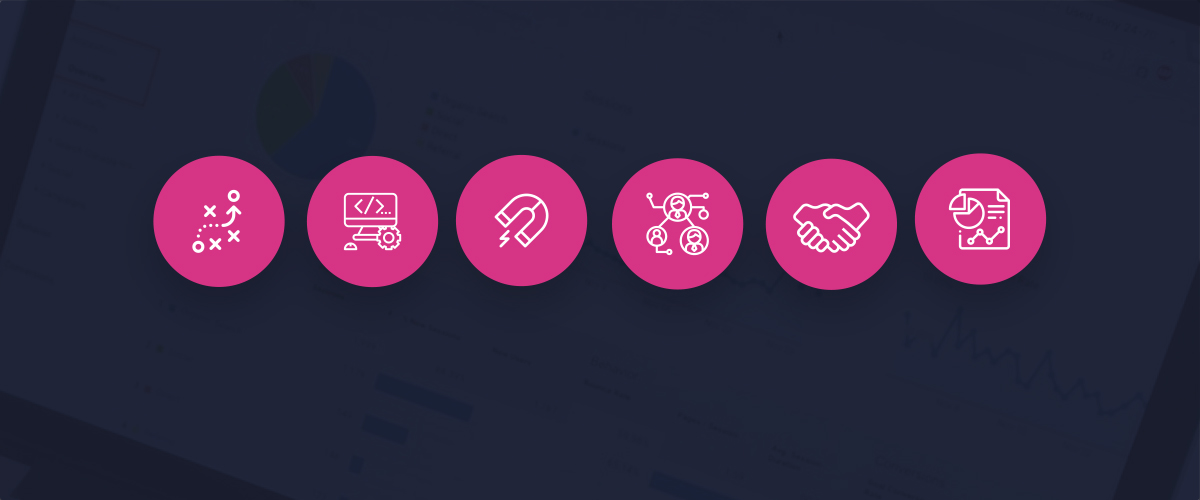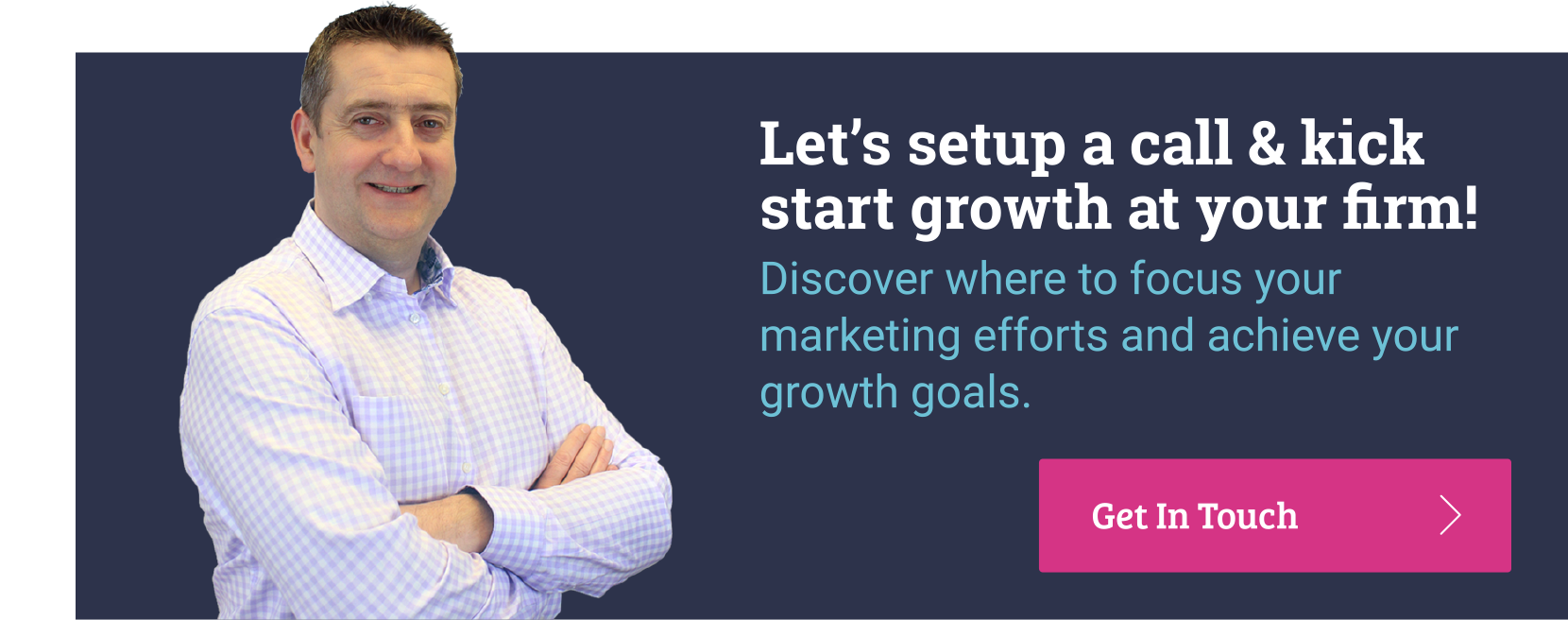
6 Essential Phases Of Business Growth Online
By John Hogg
Tags:
Digital Marketing Growth MarketingFollowing on from our last blog, “Build It And They Might Not Come”, which focused on the trend for businesses to spend all their time and energy designing a beautiful website, writing some wonderful content and then wondering why the leads aren’t coming in, this blog will explore ALL of the steps which need to be considered when a B2B company wants to use their website to attract leads and ultimately grow their business.
- Yes, you do need to build a great website and you will need great content which resonates with the pains and challenges of your target audience, however, you will also need to consider a lot of other activities as well.
- Unfortunately the creation of your digital assets only gets you to the starting line...
Stage One - The Strategy Phase
The first step to consider when looking at how to grow your business is to conduct a short exercise on Business Strategy to learn more about who the organisation actually is, where it is in the market place and where it wants to go. A lot of companies simply jump in and start to do things online and then after a while they begin to wonder why its not working.
- “If you don’t know where it is you want to go, it is going to be very difficult to actually get there.”
We have written extensively on the need to build your strategy first, however, if you are looking for a quick overview of our approach to strategic planning, why not check out our 7 Essential Steps To Revenue Growth.
You may also want to check out our Interactive Growth Calculator which people find very useful when they are trying to work out their online goals and decide where they need to focus most in order to achieve the growth they are trying to achieve. You can find the Interactive Growth Calculator here.
Stage Two - The Build Phase
As we have mentioned above, a lot of effort rightly goes into making sure an organisation has a proper website with great content on it, however, the key takeaway is to realise that this only gets you to the starting line.
Think about this phase being all about the important act of building a Formula One car which will have the capability to win the World Championship, however, to do this you need to start to drive it.
There is no point keeping the car in the garage and admiring it yet still wondering why you aren't the world champion!
Get into the Build phase today (rem. to put a time limit on it) and work out what the absolute essentials are to go live and you can then continue to add all the other bells and whistles when you are up and running.
This phase is very much about setting everything up. The Strategy phase will have worked out who your target audience is and what the pains and challenges are for each of your Buyer Personas. Now you can build your website and write great content to appeal to theses pains.
Will you have a regular blog, will you have premium content, will you use video or maybe even podcasts?
Work out what you need to go live and set up a content engine to continue to feed regular, high-quality content to your website.
Stage Three - The Traffic Phase
The third essential step on your way to generating leads and growing your business online is to start attracting your audience to your website so that they can consume your content and ultimately engage with you and become a client. This is often a telling aspect in any organisations online success. Look at your Google Analytics and understand what level of traffic your website normally gets versus the number of leads you currently receive from your website.
- If, for example, you are receiving 500 visitors to your website each month and this delivers 4 leads on average of which 2 convert into clients this might seem OK, however, if your average client is worth
£$€2,000 that’s only £$€4,000 of revenue per month when your plans might indicate that you need £$€10,000 per month in order to achieve the level of growth the business needs to achieve.
The first question you need to ask is whether or not this level of traffic is enough. What can be done to increase traffic and therefore add more people to the top of your funnel so that more will hopefully come out the bottom as clients. This obviously assumes that everything else is equal as there may also be things you can do to improve the conversion rate, close rate or maybe even the make up and price of your proposition.
The 6 key ways to drive traffic to your website include:
- SEO
- Social Media
- Paid Social or Paid Search
- Influencer Marketing
- Offline Marketing
With a healthy level of traffic and also a deep understanding of the data relating to the visitors on your website, you will begin to understand what level of traffic you will need to maintain in order to generate enough leads to feed your pipeline and achieve growth.
Stage Four - The Convert Phase (or Leads)
With a steady stream of visitors arriving at your website what is it that you want them to do? Do you just want them to read your content and then leave or will you build out a conversation path to guide them through the relevant content and encourage them to engage with you and become a lead?
One of the best ways to do this is to add a number of “Calls to Action” (CTAs) around your website to offer something for the visitor to do in order to learn more. Perhaps you have an ebook with even more information pertaining to a blog topic or perhaps you offer a Free Consultation for visitors to reach out and set up a call?
The key to creating a successful Content Plan is that it must address each stage of the Buyers’ Journey for each of your Personas. Don’t just write about one type of content and leave it at that. Look at your content and make sure you have content for the Awareness stage, Consideration stage and Decision Stage of the Buyers’ Journey
The Buyers' Journey

With content that appeals to each stage of the Buyers' Journey you will have a much better opportunity of moving interested visitors down through your funnel. Use CTAs to ‘advertise’ your premium content and take visitors who click on it to a Landing page where they can fill in their details and receive, for example, an eBook. Your business now has a lead to follow up with. This can be done through various marketing automation platforms with, for example, a series of emails issued at key times and/or by sending notifications to your sales team for follow up.
Other types of activity which can improve Conversion on a website are by using Pop Ups throughout your website to appear at specific times. Once again this will encourage website visitors to engage and 'hopefully' during the process become a lead.
Conversational Marketing initiatives can also be a useful way to stimulate engagement through either an Online Chat or by building a Chatbot for your website.
Interactive tools have also become an increasingly popular way to engage with website visitors through surveys, quizzes, polls or online calculators/ tools.
A quick summary of the main activities to consider in order to improve lead generation on your website:
- Conversion funnels (CTA, Landing Pages, Thank You Pages, etc)
- Pop Ups
- Online Chat
- Chat Bots
- Quizzes & Polls
- Online Calculators
By using a variety of these tools you can begin to test and optimise your website so that you will always have the best possible opportunity to convert as many visitors as possible into leads which can then be converted into clients.
Stage Five - The Close Phase
With a healthy level of both visitors and leads coming to your website it is crucial that a robust sales process is in place to receive theses leads and pass them to the right people so that they can try and close them as new clients for your firm.
As well as being able to automatically send notifications to the right people as soon as a lead is created it is also important to have a CRM database to store all of this information in one place and allow whomever is working on the lead to add notes regarding each of their individual touch points with the client.
When a lead arrives we tend to call them a Marketing Qualified Lead (MQL) as they will have engaged with some form of marketing activity in order to be added to the CRM. It is, however, important that your sales team conducts initial research before reaching out to them for an Exploratory conversation to establish if you are a good fit for them (and don’t forget that you need to find out if they are also a good fit for your business too!).
This will hopefully result in a Sales Qualified Lead (SQL) who your sales team or perhaps an account manager can continue to engage with to understand more and ultimately submit a Proposal and close them as a client.
The key things to consider during the Close phase therefore include:
- CRM
To contain all the information and manage your Sales Pipeline - MQL
The initial lead coming in from your website (you may also want your marketing team to find out some initial key information before the MQL is passed to the sales team) - SQL
These are the people who you now deem to be a real opportunity for your business to work with - Sales Process
Sales processes can vary a lot, however, they tend to follow this format:
i) an Exploratory Call/ Meeting;
ii) a Deep Dive or Diagnostic Call to learn more about what the Prospect needs;
iii) the Proposal Stage; and lastly,
iv) Won/ Lost. - Sales Pipeline
The number of people at each stage of your Sales Process and what can you realistically see converting to the next stage.
Stage Six - The Reporting Phase
Whilst reporting is not exactly a step which you must perform in order to convert leads into clients, without it you will be lost. The beauty of marketing your business online is that you will have access to a wealth of data to tell you how you are doing. Jump in, understand the data and start to work out what your funnel is telling you.
- Not enough visitors to your website - Do you have a traffic problem?
- Low levels of leads coming through the website? Do you have a conversion problem? This could be down to a number of reasons - the proposition itself; how you have built the funnel; headlines; or perhaps even the colour of your landing page buttons! To find out you will need to test absolutely everything and work out what resonates with your audience so that you have the best possible chance of converting visitors into leads.
- Not enough leads converting into clients? Is there a problem with the proposition/ offer? Perhaps it is something to do with your pricing? Maybe the sales team need more training or maybe even the strategy is wrong and you are attracting the wrong type of people to your website? As we said above - test absolutely everything to see what works best for your business!
In Closing
Online marketing isn’t easy, however, if you take a structured and strategic approach to it and build something which your audience needs in order to solve their pains and challenges you should be well on your way to success.
Final Tips
- Don’t ignore the strategy phase
- Don’t get bogged down at the Build phase and think that’s it
- Build an audience and use it to attract visitors to your website
- Create a conversion funnel and encourage your visitors along the buyers journey so that they will ultimately become a lead
- Establish a robust sales process which maps out your sales pipeline from one stage to the next
- Don't forget to set up reporting structures early
We hope you have found these steps useful and you begin to apply them to your own online marketing. If you would like to discuss how we go about any aspect of these stages, please feel free to set up a call and we can have a quick, no obligation chat to discuss your challenges.
If you liked this content you may also be interested in our 7 Essential Steps To Planning Your Online Growth? This is a one page guide to Strategy and can be a useful reminder to print out and place on your wall. Click the link above to get your free copy.

John Hogg
John is managing director of Enlighten IC and has been involved in legal marketing and technology marketing for over 25 years. He is passionate about how an inbound approach to marketing can help firms to drive leads and grow their business.
Get In Touch

